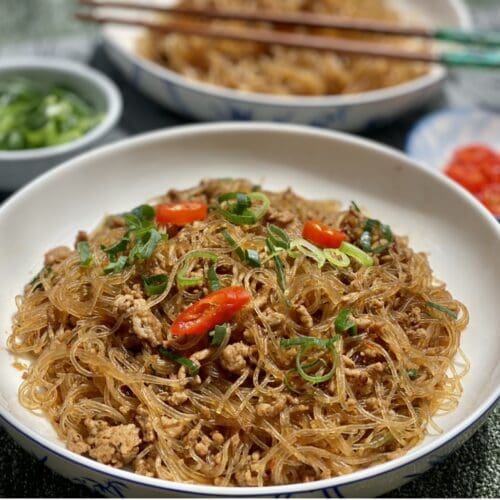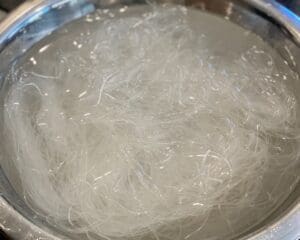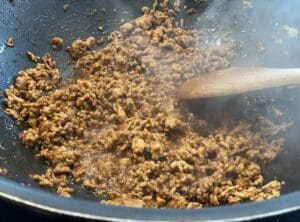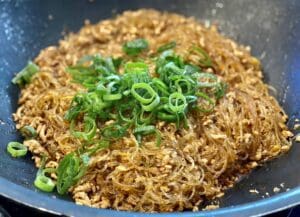
Spicy Vermicelli Noodles (Ants climbing a tree)
Looking for deep flavours but an easy meal to make on a weeknight? Why not try these delicious Sichuan-inspired Spicy Vermicelli Noodles?
Ingredients
- 200 gm dried vermicelli noodles (NOTE 1)
- 2 tbsp peanut oil
- 3 clove garlic (minced)
- 1 tbsp finely grated ginger
- 300 gm pork mince (or any ground meat)
- 2 tbsp spicy bean sauce (NOTE 2)
- 1 tbsp shaoxing wine (NOTE 3)
- 1 tbsp light soy sauce (NOTE 4)
- 1 tbsp dark soy sauce (NOTE 5)
- 2 tsp sugar
- 2 cup salt-reduced/low sodium chicken stock (500ml/17fl oz) (NOTE 6)
- ⅓ cup thinly sliced spring onion (scallion, green onion)
Instructions
- Cover the dry vermicelli noodles completely with cold tap water, and leave for 15 to 20 minutes at room temperature. Drain the noodles using a colander and set them aside for later.

- Heat oil in a large wok or deep frying pan over medium-high heat. Place in the garlic and ginger, then stir-fry for 30 seconds or until fragrant. Add in the pork and stir-fry until it's cooked, then add in the spicy bean sauce and stir it through. Pour in the wine, light and dark soy sauces and stir-fry for 1 minute.

- Add in the stock and sugar, then bring the mixture to a boil, then place in the noodles. Stir-fry until the noodles have soaked most of the liquid and they look transparent (about 3 to 4 minutes). Toss in the spring onions and stir through, then remove from the heat. Serve the Spicy Vermicelli Noodles on their own or over steamed rice.

Notes
(NOTE 1) Vermicelli bean threads - Also referred to as glass or cellophane noodles. They're thin threads usually sold in little bundles, but not to be mistaken for rice vermicelli because they look very similar. Bean vermicelli is made from mung bean starch and requires a little time to soak before use. I prefer the brand 'Lungkow' vermicelli, which I got from my local Asian grocery store.
(NOTE 2) Spicy bean sauce (or Chilli bean sauce) is a flavourful savoury sauce with deep flavours made from fermented soybeans and chilli peppers. The only brand I found was 'Lee Kum Kee' at my local Asian grocer.
(NOTE 3) Shaoxing cooking wine is a Chinese cooking wine, sometimes known as Shao Xing or Shao Hsing. It comprises water, rice, wheat, salt and alcohol. Bottles of Shaoxing wine are cheap to buy from Asian specialty stores and some supermarkets stock them too. Mirin or dry sherry are good substitutes for Shaoxing wine.
(NOTE 4) Light soy sauce or regular soy sauce but avoid the dark or sweet soy sauce varieties, as these are not interchangeable.
(NOTE 5) Dark soy sauce - The dark soy sauce variety is mainly used to add colour to a dish. It's less salty, but sweeter and thicker than regular or light soy sauce.
(NOTE 6) Chicken stock/broth - I prefer using salt-reduced or low-sodium chicken stock because I have more control over the sodium level. This way I can adjust the seasoning in dishes to my liking. It's always better to be under-seasoned than over-seasoned as it's easier to fix.
Leftovers - Allow the noodles to cool completely at room temperature, then transfer them into a sealed container and store them in the fridge. It should be good for 3 days.
I've used a third-party application to calculate the calories and nutritional information, so please use this as an approximate guide only.
Cooking measurements are in Australian standard spoon and cup measurements. For specific details and conversions, visit our Australian Cooking Measurements page.
Nutrition
Serving: 1servingCalories: 492kcalCarbohydrates: 52gProtein: 17gFat: 24gSaturated Fat: 7gPolyunsaturated Fat: 4gMonounsaturated Fat: 11gCholesterol: 54mgSodium: 390mgPotassium: 371mgFiber: 1gSugar: 5gVitamin A: 89IUVitamin C: 3mgCalcium: 39mgIron: 2mg